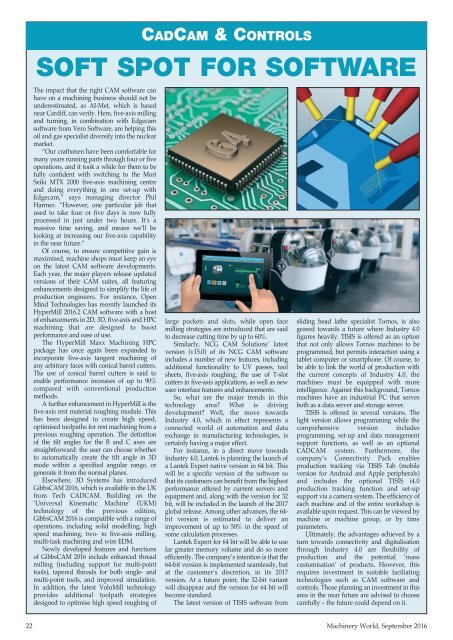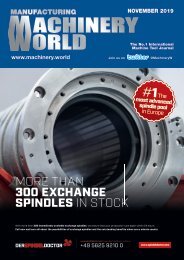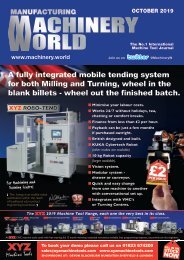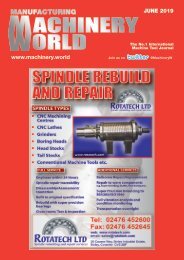Machinery World - September 2016
Create successful ePaper yourself
Turn your PDF publications into a flip-book with our unique Google optimized e-Paper software.
The impact that the right CAM software can<br />
have on a machining business should not be<br />
underestimated, as AI-Met, which is based<br />
near Cardiff, can verify. Here, five-axis milling<br />
and turning, in combination with Edgecam<br />
software from Vero Software, are helping this<br />
oil and gas specialist diversify into the nuclear<br />
market.<br />
“Our craftsmen have been comfortable for<br />
many years running parts through four or five<br />
operations, and it took a while for them to be<br />
fully confident with switching to the Mori<br />
Seiki MTX 2000 five-axis machining centre<br />
and doing everything in one set-up with<br />
Edgecam,” says managing director Phil<br />
Harmer. “However, one particular job that<br />
used to take four or five days is now fully<br />
processed in just under two hours. It’s a<br />
massive time saving, and means we’ll be<br />
looking at increasing our five-axis capability<br />
in the near future.”<br />
Of course, to ensure competitive gain is<br />
maximised, machine shops must keep an eye<br />
on the latest CAM software developments.<br />
Each year, the major players release updated<br />
versions of their CAM suites, all featuring<br />
enhancements designed to simplify the life of<br />
production engineers. For instance, Open<br />
Mind Technologies has recently launched its<br />
HyperMill <strong>2016</strong>.2 CAM software with a host<br />
of enhancements in 2D, 3D, five-axis and HPC<br />
machining that are designed to boost<br />
performance and ease of use.<br />
The HyperMill Maxx Machining HPC<br />
package has once again been expanded to<br />
incorporate five-axis tangent machining of<br />
any arbitrary faces with conical barrel cutters.<br />
The use of conical barrel cutters is said to<br />
enable performance increases of up to 90%<br />
compared with conventional production<br />
methods.<br />
A further enhancement in HyperMill is the<br />
five-axis rest material roughing module. This<br />
has been designed to create high speed,<br />
optimised toolpaths for rest machining from a<br />
previous roughing operation. The definition<br />
of the tilt angles for the B and C axes are<br />
straightforward: the user can choose whether<br />
to automatically create the tilt angle in 3D<br />
mode within a specified angular range, or<br />
generate it from the normal planes.<br />
Elsewhere, 3D Systems has introduced<br />
GibbsCAM <strong>2016</strong>, which is available in the UK<br />
from Tech CADCAM. Building on the<br />
‘Universal Kinematic Machine’ (UKM)<br />
technology of the previous edition,<br />
GibbsCAM <strong>2016</strong> is compatible with a range of<br />
operations, including solid modelling, high<br />
speed machining, two- to five-axis milling,<br />
multi-task machining and wire EDM.<br />
Newly developed features and functions<br />
of GibbsCAM <strong>2016</strong> include enhanced thread<br />
milling (including support for multi-point<br />
tools), tapered threads for both single- and<br />
multi-point tools, and improved simulation.<br />
In addition, the latest VoluMill technology<br />
provides additional toolpath strategies<br />
designed to optimise high speed roughing of<br />
CADCAM & CONTROLS<br />
SOFT SPOT FOR SOFTWARE<br />
large pockets and slots, while open face<br />
milling strategies are introduced that are said<br />
to decrease cutting time by up to 60%.<br />
Similarly, NCG CAM Solutions’ latest<br />
version (v15.0) of its NCG CAM software<br />
includes a number of new features, including<br />
additional functionality to UV passes, tool<br />
sheets, five-axis roughing, the use of T-slot<br />
cutters in five-axis applications, as well as new<br />
user interface features and enhancements.<br />
So, what are the major trends in this<br />
technology area? What is driving<br />
development? Well, the move towards<br />
Industry 4.0, which in effect represents a<br />
connected world of automation and data<br />
exchange in manufacturing technologies, is<br />
certainly having a major effect.<br />
For instance, in a direct move towards<br />
Industry 4.0, Lantek is planning the launch of<br />
a Lantek Expert native version in 64 bit. This<br />
will be a specific version of the software so<br />
that its customers can benefit from the highest<br />
performance offered by current servers and<br />
equipment and, along with the version for 32<br />
bit, will be included in the launch of the 2017<br />
global release. Among other advances, the 64-<br />
bit version is estimated to deliver an<br />
improvement of up to 50% in the speed of<br />
some calculation processes.<br />
Lantek Expert for 64 bit will be able to use<br />
far greater memory volume and do so more<br />
efficiently. The company’s intention is that the<br />
64-bit version is implemented seamlessly, but<br />
at the customer’s discretion, in its 2017<br />
version. At a future point, the 32-bit variant<br />
will disappear and the version for 64 bit will<br />
become standard.<br />
The latest version of TISIS software from<br />
sliding head lathe specialist Tornos, is also<br />
geared towards a future where Industry 4.0<br />
figures heavily. TISIS is offered as an option<br />
that not only allows Tornos machines to be<br />
programmed, but permits interaction using a<br />
tablet computer or smartphone. Of course, to<br />
be able to link the world of production with<br />
the current concepts of Industry 4.0, the<br />
machines must be equipped with more<br />
intelligence. Against this background, Tornos<br />
machines have an industrial PC that serves<br />
both as a data server and storage server.<br />
TISIS is offered in several versions. The<br />
light version allows programming while the<br />
comprehensive version includes<br />
programming, set-up and data management<br />
support functions, as well as an optional<br />
CADCAM system. Furthermore, the<br />
company’s Connectivity Pack enables<br />
production tracking via TISIS Tab (mobile<br />
version for Android and Apple peripherals)<br />
and includes the optional TISIS i4.0<br />
production tracking function and set-up<br />
support via a camera system. The efficiency of<br />
each machine and of the entire workshop is<br />
available upon request. This can be viewed by<br />
machine or machine group, or by time<br />
parameters.<br />
Ultimately, the advantages achieved by a<br />
turn towards connectivity and digitalisation<br />
through Industry 4.0 are flexibility of<br />
production and the potential ‘mass<br />
customisation’ of products. However, this<br />
requires investment in suitable faciliating<br />
technologies such as CAM software and<br />
controls. Those planning an investment in this<br />
area in the near future are advised to choose<br />
carefully – the future could depend on it.<br />
22 <strong>Machinery</strong> <strong>World</strong>, <strong>September</strong> <strong>2016</strong>

















